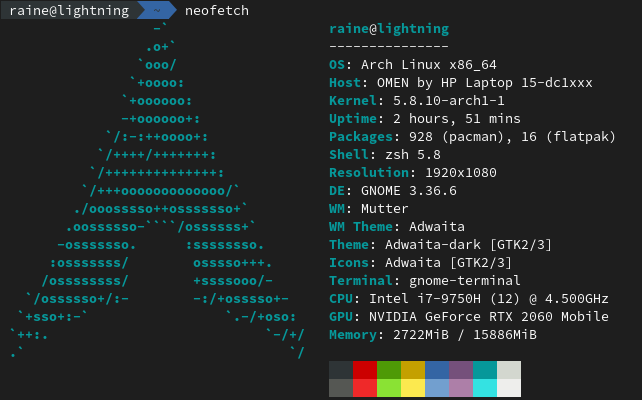Flatpaks are awesome. Flathub is awesome. :)
- 4 Posts
- 194 Comments
Where’s the camera?

 2·5 days ago
2·5 days agoExpanding on yours, Shift + Home and Shift + End to select from the cursor to the beginning or end of the line.
I’ll just take whatever. I’m not picky.

 1·11 days ago
1·11 days agoNothing inherently, but it’s a rolling release, so the further away from the latest versions you are, the more likely something is going to prevent you from updating. Arch is the same way, but Steam OS is based on Arch snapshots, not a rolling release.
You kinda have to watch after rolling releases pretty constantly in order to keep them up to date and make sure they don’t get left behind.

 26·13 days ago
26·13 days agoManjaro Linux is a really bad choice. I’d like my gaming console to be able to update if I turn it on after two years.
I have all Reolink cameras and they’re awesome. They have both indoor and outdoor cameras. They’re really expensive compared to other similar cameras, but the software is really good, and there’s no subscription. You don’t even need to log in. Everything is only stored locally, on either SD cards in the camera or a separate “home hub” (or both). They have motion and object detection built into the cameras.
The way I have them set up is every indoor camera is plugged into a smart outlet that disconnects their power through Home Assistant when either me or my wife are home.
The outdoor ones are connected to solar power, so I didn’t even have to run any wires.
I’d highly recommend them.

 21·15 days ago
21·15 days agoYou have to be really into Star Trek or terminally online to even hope to understand why anyone would be laughing at a toy and a pack of lights on a store shelf.
Oh I got this. Real good fuck up. So, I run a bunch of services for me and family and friends, like Nextcloud, Immich, Mastodon, etc. All of their data is stored on a big RAID array built with mdadm. I built it before I knew about dm-integrity, so I wanted to rebuild it with dm-integrity running on all the disks. So I took out one disk (it’s a RAID6, so it can stand losing a disk just fine), and added dm-integrity on top of it. When I tried to add it back to the array, mdadm was like, “that’s not a big enough device”. Ok, yeah, makes sense, dm-integrity takes up some space. So I took all the services offline and started a resize2fs to reduce from 22TB to 18TB. Well that was taking forever, so I canceled and ran e2fsck, no worries. I started a new resize2fs reducing from 22TB to 21.8TB, which should be good enough. On pass 4, it’s looking like it’s gonna take 8 DAYS. I can’t have my services offline for that long, so I cancel and run e2fsck. Thousands of errors. Oops.
At least it’s looking like all the errors are just in Mastodon’s cache files.
So now I’m moving all the files to an external drive in order to migrate the array properly. In its degraded state though, the array is painfully slow. At least my services are online.
So basically I risked my files (though I have a backup from about three days before all this), and gave myself an extra maybe ten days(?) of work.
Moral of the story, don’t ever use resize2fs unless you have time to wait.
I’d like to see the Atari write a shitty article about the seven best and worst kinds of moviegoers. Or role play with me that they are a 300 year old sparkly vampire and I am an insufferable teenage girl with zero friends or ability to emote proper human emotions.

 1·18 days ago
1·18 days agoSafe, yeah. Private, no. If you want to verify whether a user is a real person, you need very personally identifiable information. That’s not ever going to be private.
The best you could do, in theory, is have a government service that takes that PII and gives the user a signed cryptographic certificate they can use to verify their identity. Most people would either lose their private key or have it stolen, so even that system would have problems.
The closest to reality you could do right now is use Apple’s FaceID, and that’s anything but private. Pretty safe though. It’s super illegal and quite hard to steal someone’s face.
Dead Like Me is fairly slow, but really interesting. Same with Coupling. Two great shows.
Torvalds should be nowhere near that man.
This is really unsettling. Like seeing Tesla and Edison.
“android” is the version of the Linux kernel it’s using. It’s still the Linux kernel.
Here’s one of Arch showing the “arch” version of the kernel:

So, Jellyfin is one of those apps where the Docker documentation is really lacking. I’m gonna give you my
docker-compose.ymlfile in case it helps:services: jellyfin: image: jellyfin/jellyfin user: 0:0 restart: 'unless-stopped' ports: - '8096:8096' environment: #- JELLYFIN_CACHE_DIR=/var/cache/jellyfin #- JELLYFIN_CONFIG_DIR=/etc/jellyfin - JELLYFIN_DATA_DIR=/var/lib/jellyfin - JELLYFIN_LOG_DIR=/var/log/jellyfin volumes: - ./config:/config - ./cache:/cache - ./data:/var/lib/jellyfin - ./log:/var/log/jellyfin - /data/jellyfin:/data/jellyfin devices: - /dev/driFor me
/data/is my RAID array, which is why my jellyfin data directory is there. Everything else goes in the same directory as the compose file. My system has a graphics card that does transcoding (Arc A380), so I have/dev/driunder devices.You should learn a lot about Docker Compose, because it will help you tremendously. I use Jellyfin behind an Nginx Proxy Manager reverse proxy. I’d highly recommend it. Here’s my compose file for that:
services: app: image: 'jc21/nginx-proxy-manager:latest' restart: unless-stopped network_mode: "host" #ports: # - '80:80' # - '81:81' # - '443:443' volumes: - ./data:/data - ./letsencrypt:/etc/letsencryptRunning in “host” mode is important, instead of just forwarding ports, because it lets you forward things to localhost, like pointing
https://media/.[mydomain]/tohttp://127.0.0.1:8096/for Jellyfin.Anyway, best of luck to you, and I hope that helps!
Use Portainer if you don’t want anything to be portable. There are other issues too. Just use Docker Compose.
Is there a reason you’re not using Docker?

 151·24 days ago
151·24 days agoSocial media is not a news source.










Nephele with SERVE_LISTINGS turned on and a read only mount.
It shows listings in the browser, just like Apache, but can also be accessed with a file browser, because it’s a WebDAV server.